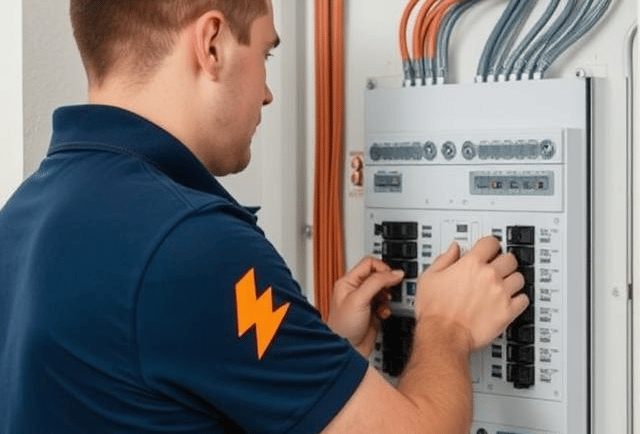What is an Electrical Inspection Condition Report
This post is describing what an E.I.C.R. is and its purpose.
Jim Ascroft
6/5/2025


An Electrical Installation Condition Report (EICR) is a comprehensive inspection and test of a property's electrical installation to ensure it's safe and fit for continued service. It assesses the condition of wiring, sockets, consumer units (circuit breaker or fuse boards), and other fixed electrical parts, identifying any potential hazards or defects.
Key aspects of an EICR:
Inspection and Testing:
A qualified approved electrician inspects the electrical installation visually and then conducts a series of tests to check its safety.
Assessment of Hazards:
The EICR can identify potential risks like electric shock, fire or other hazards.
Recommendations:
The report provides recommendations for repairs or improvements to address any identified issues.
Compliance:
EICRs are often required for landlords to comply with regulations, ensuring their rental properties are electrically safe.
Who requires an E.I.C.R?:
Anyone Who Owes a Duty of Care:
The duty of care to maintain a safe environment is a legal obligation that applies to landlords and business owners. This includes ensuring that all electrical installations are safe.
In summary, anyone who owns or operates a building where people work or live has a duty to ensure the electrical installations are safe and comply with relevant regulations. This often translates into the need for an EICR.
What to expect during an EICR:
1. Visual Inspection:
The electrician will visually examine the electrical components, looking for signs of damage or deterioration in order to ascertain if its safe to continue to the electrical tests.
2. Electrical Tests:
They will conduct various tests, including continuity checks, insulation resistance tests, and earth fault loop impedance tests.
3. Report Generation:
A detailed EICR report will be generated, summarizing the findings and recommendations.
4. Remedial Work:
If any defects are identified, the electrician may recommend repairs or upgrades to address them.
In essence, an EICR is a safety check to ensure your property's electrical installation is functioning safely and meeting current standards, helping to prevent accidents and comply with regulations.
The sequence to conduct a three phase E.I.C.R.
Conducting a three-phase Electrical Installation Condition Report (EICR) involves a systematic sequence of visual inspections and dead and live electrical tests to assess the safety and condition of the entire system
.The procedure is more complex than a single-phase EICR due to the multiple live conductors and is based on the IET Wiring Regulations (BS 7671).
Pre-inspection steps
Preparation and client consultation: Discuss the purpose, extent, and limitations of the EICR with the client. For instance, agree on which areas and accessories will be inspected, as well as the need for any shutdowns.
Gather documentation: Collect any previous reports, certificates, or diagrams for the installation.
Site assessment: Before any testing, conduct a walk-through to identify the main switch, distribution boards, all circuits, and potential safety hazards.
Step 1: Visual inspection (Pre-energisation)
A thorough visual check is the first and most crucial step. The system must remain energised at this stage. Check for:
Damaged, cracked, or improperly installed electrical equipment.
Signs of overheating, such as discoloration on enclosures or wiring.
Adequate access and working space around distribution boards and equipment.
Correct labeling of circuits and protective devices.
Condition of the enclosure, including any damage or missing parts.
Evidence of alterations or additions since the last inspection.
A representative number of terminations and connections at accessories like sockets and switches.
Step 2: Dead electrical tests
Isolate the entire electrical installation from the main supply before performing these tests. All connected loads and sensitive electronic equipment must be disconnected or isolated from the circuits under test.
Continuity of protective conductors: Use a low-resistance ohmmeter to confirm the continuity of all protective conductors, including main and supplementary bonding. For three-phase, test the continuity between the main earth terminal and the earth terminal of each piece of three-phase equipment.
Continuity of ring final circuit conductors (if applicable): If the installation contains ring circuits, test the continuity of the line, neutral, and earth conductors.
Insulation resistance testing: Set the insulation resistance tester to 500V DC. Test the insulation between:
Phase conductors L1, L2, L3 connected together, and the neutral and earth connected together.
L1 and L2, L1 and L3, and L2 and L3.
L1, L2, and L3 connected together, and the neutral.
Each phase conductor and earth individually.
Each phase conductor and neutral individually.
The neutral and earth conductors.
Polarity: On three-phase systems, ensure that phase conductors are correctly connected at all switchgear, distribution boards, and equipment. Incorrect polarity can cause damage to equipment.
Step 3: Live electrical tests
Restore the power supply to the installation with caution. Live testing must be carried out by a competent person using the appropriate test equipment.
External earth fault loop impedance (
Ze
𝑍𝑒
): Disconnect the main earthing conductor and measure the impedance of the earth fault loop external to the installation. Record the highest reading from each phase.
Earth fault loop impedance (
Zs
𝑍𝑠
): At the furthest point of each circuit, measure and record the earth fault loop impedance. This can be compared with the maximum allowable values for the protective device.
Prospective fault current (
Ipfc
𝐼𝑝𝑓𝑐
): Measure the prospective fault current at the origin of the installation. This confirms that the protective devices have an adequate breaking capacity.
Residual Current Device (RCD) testing: Test all RCDs and RCBOs to verify they trip within the required time limits at 1x and 5x the rated tripping current.
Phase rotation: Use a dedicated phase rotation meter to check that the correct phase sequence (e.g., L1-L2-L3) is present at three-phase sockets and equipment. This is critical for motors to rotate in the correct direction.
Functional tests: Check the correct operation of all switches, isolators, and other controls.
Step 4: Documentation and reporting
After completing all inspections and tests, document the findings accurately on the EICR form.
Record observations: List any observations, damage, or defects found during the inspection and testing.
Assign classification codes: Use the standard classification codes to indicate the severity of any issues:
C1: Danger present. Risk of electric shock or fire. Immediate remedial action is required.
C2: Potentially dangerous. Urgent remedial action is required.
C3: Improvement recommended. The installation is safe, but improvements are recommended to meet modern standards.
FI: Further investigation is required. Used when the extent of an issue cannot be determined at the time of the inspection.
Overall assessment: Based on the observations and codes, provide an overall assessment of the installation as either "Satisfactory" or "Unsatisfactory".
Recommendations: Clearly outline the necessary remedial actions in the report.
Certificate completion: Fill out all sections of the EICR form, including the supply characteristics, earthing arrangements, and test results, before issuing it to the client.
The Importance of Bonding Conductors
Bonding conductors connect metallic parts of an electrical installation and its surroundings to an earthing system to keep them at the same electrical potential, preventing dangerous voltage differences that could cause electric shock, sparks, or fires. By providing multiple paths for fault current and reducing overall loop impedance, bonding also helps protective devices operate more quickly, enhancing safety. There are two main types: main protective bonding, which connects the main water, gas, and structural steel, and supplementary bonding, which connects other metallic services and items in local areas like bathrooms and kitchens.
What bonding conductors do:
Prevent Electric Shocks:
The primary function of bonding is to reduce the risk of electric shock. When there's an electrical fault, bonding conductors ensure that all interconnected metal parts (like pipes and equipment casings) remain at the same potential, so a person touching two different metallic surfaces won't experience a significant voltage difference.
Limit Touch Voltage:
By connecting conductive parts to the earthing system, bonding helps to limit the magnitude of the touch voltage that could appear on these parts during a fault.
Enhance Fault Current Path:
Bonding provides parallel paths for fault currents, which reduces the overall resistance of the fault loop.
Speed up Protective Device Operation:
A lower fault loop impedance results in a higher fault current, which causes protective devices like fuses or circuit breakers to trip and disconnect the power supply more quickly, further protecting people from harm.
Control Spark Ignition:
In potentially flammable environments, bonding is essential to prevent the ignition of flammable gases or dust by static electricity or arcing.
Types of bonding:
Main Protective Bonding:
This connects the main earthing terminal to the structural steel, metallic water, gas, and oil pipes entering the building.
Supplementary Bonding:
This connects other metallic services and parts together, such as metallic water pipes, gas pipes, and electrical services in high-risk areas like bathrooms and kitchens, to ensure they are at the same potential as the earthing system.
Services
Expert electrical solutions for homes and businesses.
Contact
About
jim@kaimelectricallimited.co.uk
07525364945
© 2025. All rights reserved.
